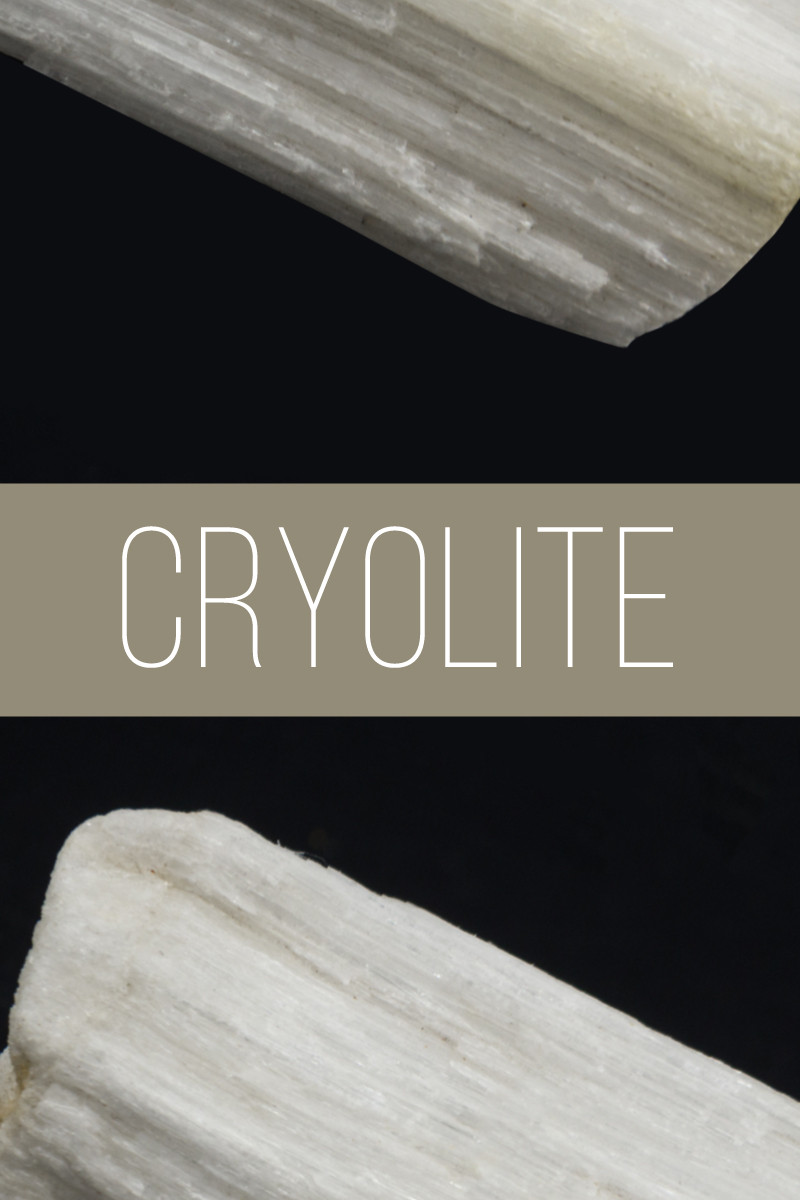
氷晶石の宝石:特性、意味、価値など
 氷晶石は、グリーンランド産の希少な白色または無色のハロゲン化物グループ鉱物です。氷塊のような外観をしていますが、宝飾品としてではなく、コレクターの珍品として扱われています。
氷晶石は、グリーンランド産の希少な白色または無色のハロゲン化物グループ鉱物です。氷塊のような外観をしていますが、宝飾品としてではなく、コレクターの珍品として扱われています。
装飾品としてはあまり使われていないにもかかわらず、この石は歴史において重要な役割を果たしてきました。氷晶石がなければ、アルミニウムは1900年代に最も多く生産された金属の一つとなり、戦争の勝利に貢献し、さらには最初の飛行機の飛行にも貢献することはなかったでしょう。
もっと詳しく知りたいですか?一緒に、クライオライトの用途、歴史、価値などの秘密を探っていきましょう!
 画像クレジット: ディディエ・デスクーエン、氷晶石 - トポタイプ - パリ薬学部旧コレクション |クリエイティブ・コモンズ 表示-継承 3.0 非移植ライセンス
画像クレジット: ディディエ・デスクーエン、氷晶石 - トポタイプ - パリ薬学部旧コレクション |クリエイティブ・コモンズ 表示-継承 3.0 非移植ライセンス
氷晶石とは何ですか?
氷晶石は半貴石である蛍石と関連があります。科学者は蛍石を使って合成氷晶石を作ることがあります。
天然のクライオライトは、無色、白、黄色、紫、黒など様々な色があります。占星術師は、風の星座である双子座と水瓶座の方にお勧めの石としてクライオライトを推奨しています。
氷晶石は、次のように数多くの工業用途に使用されています。
花火(黄色になります)
ガラス(白くて不透明になり、歴史的には義眼に人気がありました)
殺虫剤と農薬
エナメルとセラミック(結合研磨剤と釉薬の充填剤)
しかし、最も重要な用途はアルミニウムの抽出です。
アルミニウム抽出に使用される氷晶石
1800年代初頭、科学者たちはアルミニウムを豊富に含む岩石ボーキサイトを電気分解してアルミニウムを分離しました。電気分解とは、物質を溶かし、電流を流すことです。
残念ながら、ボーキサイトを溶かすには非常に高い温度が必要であり、コスト効率よく行うには高すぎます。
しかし、溶融した氷晶石を加えると融点が下がり、導電性が高まり、分離(溶解)プロセスが促進され、アルミニウムを得るための電気分解がより安価で効率的になります。
氷晶石の仕様と特徴
氷晶石の化学式はNa3AlF6で、フッ化アルミニウムナトリウムまたはヘキサフルオロアルミン酸ナトリウムと表記されます。アルミニウムは氷晶石の13%を占めています。
この鉱物は、蛍石、シルバイト、岩塩とともにハロゲン化物グループに属します。このグループの鉱物はハロゲン塩であり、ナトリウム、フッ化物、および/または塩酸が金属と反応して生成される塩です。
氷晶石は通常、粒状の塊を形成します。小さな柱状結晶を形成することもありますが、これは稀です。また、様々な種類の双晶もよく見られます。
石の他の色は、黄鉄鉱の真鍮のような黄色や閃亜鉛鉱の赤褐色のように、ほとんどの場合鉱物の含有物によるものです。
氷晶石鉱物のその他の特性は次のとおりです。
モース硬度:2.5~3
色: 通常は無色から白色。わずかに茶色、赤色、黄色がかる場合もあります。まれに紫色、灰色、黒色になることもあります。
結晶構造:単斜晶系
光沢:ガラス質~油状、真珠光沢 [001]
透明性: 半透明。まれに透明
屈折率:1.338-1.339
密度:2.95~3.00
へき開:なし、ただし3方向に分かれる(擬似立方へき開)
骨折:不均一
縞模様:白
発光: 弱い熱ルミネセンス(熱誘起発光); 時には蛍光とリン光(SW-UVでは明るい黄色、LW-UVでは薄い黄色); カナダ産の標本の中にはSW-UVで薄い青色の蛍光を発するものもある
氷晶石の最も魅力的な特性の一つは、水中で目に見えないことです。
氷晶石の屈折率は1.338で、水の屈折率(1.333)に非常に近いため、無色の氷晶石を水に浸すと、まるで突然消えたかのように見えなくなります。
この不思議な出来事は、初期の氷晶石の結晶の意味において役割を果たしました。
氷晶石の意味と歴史
グリーンランド氷晶石は、公式に発見されるずっと前から、原住民のイヌイットの間で知られており、「決して溶けない氷」というあだ名が付けられていました。
さらに、彼らは、クライオライトが水中で「消える」という神秘的な性質を持つことから、不幸やストレスも同時に消え去ることができると信じていました。
今日、クライオライトは悟り、変容、精神性を象徴しています。
「クリオライト」という名称は、ギリシャ語で「氷」を意味する「クリオス」に由来しています。その由来については諸説あり、氷のような外観、極寒のグリーンランドで発見されたこと、吹き矢の下で凍った海水のように溶ける性質などが挙げられます。
最初の公式発見
氷晶石に関する最初の公式な記述は 1799 年になされました。デンマークの医師ペーダー・クリスチャン・アビルドゴーは 1798 年にグリーンランドのイヴィットゥート (当時はイヴィグトゥート) を訪れました。彼は独特の「白い、スパーのような」鉱物を発見し、デンマークに持ち帰りました。
アビルドゴーはこの新しい鉱物に関する報告書を書き、1799年版の『General Journal of Chemistry』 (ドイツ語から翻訳)に掲載し、数年後にはデンマーク王立科学協会に「氷晶石」として提出した。
同年、J・W・テイラー率いるイギリスの技術者たちがイヴィットゥートで採掘作業を開始したが、その目的は鉛と銀であった。この試みは実りあるものの、長くは続かなかった。
 画像クレジット: 『Cranberries; : the national cranberry magazine』(1936年) 36ページより | 出版社: Portland, CT [その他] : Taylor Pub. Co. [その他]
画像クレジット: 『Cranberries; : the national cranberry magazine』(1936年) 36ページより | 出版社: Portland, CT [その他] : Taylor Pub. Co. [その他]
アルミニウム用氷晶石の台頭
当初、氷晶石はアルミニウムの微量な供給源であり、水酸化ナトリウム(苛性ソーダ)の製造原料でしかありませんでした。しかし、発見からほぼ1世紀後、ついに重要な用途が生まれました。氷晶石は何に使われていたのでしょうか?アルミニウムの抽出です!
1886年、シャルル・マルタンとポール・エルーという2人の化学者が、アルミニウム抽出用の融剤としての氷晶石の利点を同時に(しかし別々に)発見しました。ホール・エルー法と呼ばれるこの発見により、氷晶石は欠かせないものとなりました。
かつては希少で高価な金属だったアルミニウムは、かつてないほど安価で入手しやすくなりました。家庭用品以外にも、アルミニウムは耐久性がありながら軽量であることから、航空機への応用が最も顕著でした。
1903年にライト兄弟が主にアルミニウム製の航空機で有名な飛行を成功させて以来、アルミニウムは航空業界で非常に貴重なものとなり、「翼のある金属」というニックネームが付けられました。
アルミニウム抽出用の氷晶石は非常に貴重であったため、第二次世界大戦中、アメリカ軍は航空機の材料をドイツから守るためにイヴィットゥートの鉱山を厳重に警備しました。
合成氷晶石と鉱物の枯渇
アルミニウムの需要が増加するにつれ、天然の氷晶石では供給が追いつかないことが明らかになったため、科学者たちは合成を試みるようになりました。1933年、ソビエトの科学者たちは合成氷晶石の製造方法を解明し、工業用途で広く利用されるようになりました。
グリーンランド鉱床での採掘は、商業的な供給が枯渇した1987年まで続けられました。1960年以降、最後の氷晶石は新設のエア・グリーンランド航空に供給されました。
(天然の)氷晶石が革命的な素材から事実上絶滅したように、イヴィットゥートは世界最大の氷晶石鉱山から廃墟となったゴーストタウンに変貌しました。
幸いなことに、現在でも合成クライオライトは豊富にあり、このクリスタルをヒーリングに使用するために航空業界に従事する必要はありません。
 画像クレジット: Ra'ike | GNUフリードキュメンテーションライセンス
画像クレジット: Ra'ike | GNUフリードキュメンテーションライセンス
氷晶石の治癒特性
合成水晶も天然水晶もヒーリングストーンとして機能します。
クライオライトは他の白い宝石と同様の特性を持ち、浄化のエネルギーを発し、バランスと精神性を高めると信じられています。実際、クライオライトは「高波動」のクリスタルとして宣伝されており、その力はすぐに感じられるほど強いとされています。
では、クライオライトの治癒特性とは何でしょうか?
身体の治癒
クライオライトクリスタルの物理的な効能としては、言語障害の改善や身体機能の調整などが挙げられます。また、脳を刺激し、情報の理解や記憶に困難を抱える人の学習を助けるとも言われています。
感情的な癒し
クライオライトは、真の自分を発見し、自分の強みを受け入れることで、恐怖を克服するのに役立つと言われています。クリスタルヒーラーは、自己認識を高め、創造性を高め、もはや役に立たなくなった習慣や信念を払拭するためにクライオライトを使用します。
チャクラヒーリング
すべてのクリスタルは、ブロックされたエネルギーセンター(チャクラ)に働きかけ、ネガティブな影響を解消するチャクラストーンとして機能します。特にクライオライトは第三の目チャクラに効果的です。
額の真ん中にある第三の目は、直感と精神的な知恵を司ります。このチャクラがブロックされていると、集中力や方向性を見失う可能性があります。クライオライトを使ってチャクラを開くことで、目的意識と洞察力が得られます。
スピリチュアルヒーリング
高振動のクリスタルであるクライオライトは、精神、心、魂を統合する瞑想におすすめです。
スピリチュアル実践者も、高次の存在とつながり、自然な超能力の発現を促すためにクライオライトを使用します。
氷晶石の宝石特性
ご存知の通り、クライオライトは宝石として使われることはほとんどありません。少数の結晶がファセットカットされたものの、現在では希少価値が極めて高くなっています。たとえ残っているとしても、ファセットカットされた宝石としてはごく小さなものしか採れません。
合成クライオライトであっても、天然素材と同様の柔らかさと脆さを持ち、アクセサリーとしてのメンテナンスは同様に困難です。国際的な企業がクライオライトを使ったジュエリーを製造している場合もありますが、コレクションとしてクライオライトの結晶や標本を目にすることが多いでしょう。
合成物についてですが、合成氷晶石はどうやって作られるのでしょうか?
合成繊維
合成粒状氷晶石の製造は、通常、水酸化アルミニウムとフッ化水素酸から始まります。この2つが反応して新たな酸が生成されます。次に、塩化ナトリウムを用いて、この新しく生成された酸をナトリウム塩に変換します。こうして合成氷晶石が完成します。
さて、本物の氷晶石はどのようにして形成されるのでしょうか?
 画像クレジット: Rob Lavinsky、iRocks.com – CC-BY-SA-3.0
画像クレジット: Rob Lavinsky、iRocks.com – CC-BY-SA-3.0
氷晶石の形成と起源
グリーンランド産の氷晶石は、花崗岩ペグマタイト内部で、菱鉄鉱や鉄分を多く含む方鉛鉱など、多くの希少鉱物とともに形成されました。アルカリ岩中にも形成されることがあります。
塩として、氷晶石は塩水(湖や海)が蒸発することによって形成されます。氷晶石の内部や表面には、菱鉄鉱などの鉱物がよく見られます。
採掘場所
氷晶石はまだ採掘されていますか?少量ですが、採掘されています。グリーンランドの鉱床は1980年代に「商業的に採掘不可能」と宣言されましたが、他の地域でも少量は採掘されています。
では、氷晶石はどこで見つかるのでしょうか?
ブラジル
カナダ
ナミビア
ロシア
スペイン
アメリカ合衆国(コロラド州、バージニア州)
つまり、まだクライオライトの結晶が見つかるってことですね!でも、クライオライトっていくらするんですか?
氷晶石の価格と価値
希少ではあるものの、クライオライトは比較的お手頃な価格です。グリーンランド産のクライオライトは価格が高く、小さな結晶だと100ドルから600ドル程度です。
グリーンランド以外で採れる氷晶石の結晶は、一般的に12ドルから50ドルです。タンブルストーンはさらにお手頃で、通常10ドルから30ドルです。原石は他の鉱物が含まれているかどうかで価格が変動しますが、通常は15ドルから100ドルで取引されます。
氷晶石のケアとメンテナンス
高濃度のフッ化物の危険性を知っている人は、「氷晶石は有毒なのか?」と疑問に思うかもしれません。確かに多少はあります。米国環境保護庁は氷晶石を「中程度の刺激物」に分類していますが、本当に危険なのは、高温下で氷晶石の粉末を扱うことです。
さて、 宝石のケアについてお話しましょう。氷晶石は水に完全に溶けるわけではありませんが、わずかに溶けます。氷晶石は塩化アルミニウム溶液または硫酸溶液に完全に溶けます。
最も安全な洗浄方法は、柔らかいブラシ、ぬるま湯、そして低刺激性の石鹸を使用することです。その後、石をすすいでください。ただし、長時間水に浸したままにしないでください。柔らかく埃のない布で、石についた水を優しく拭き取ってください。こすったり拭いたりしないでください。
氷晶石のようなクリスタルをお探しですか?
クライオライトの重要性のほとんどは過去のものですが、いまだに過小評価されている不思議な石です。強力なヒーリング効果を持つスピリチュアルなクリスタルをお探しの方にも、近代史の流れを変えたとされる革新的な遺物をお探しの方にも、クライオライトはまさにうってつけの石です。
Gemstone Encyclopedia検索
最新記事
ヤシ象牙彫刻は、植物象牙とも呼ばれ、南米のヤシ科植物フィテレファス属のヤシの実から倫理的に採取された、象牙の天然代替品です。このガイドでヤシ象牙についてすべて学びましょう!
15th Jan 2026
レインボーラティスサンストーンは、様々な内包物によって3つのゴージャスな光学的効果を持つ長石の一種です。燃えるように鮮やかな色合いと格子模様が、コレクターにとって希少な宝石となっています。
12th Jan 2026
記事のカテゴリ
How To's is where you will find helpful articles from gem Rock Auctions on how to cut gemstones, select gemstones and buy gemstones.
9記事数
